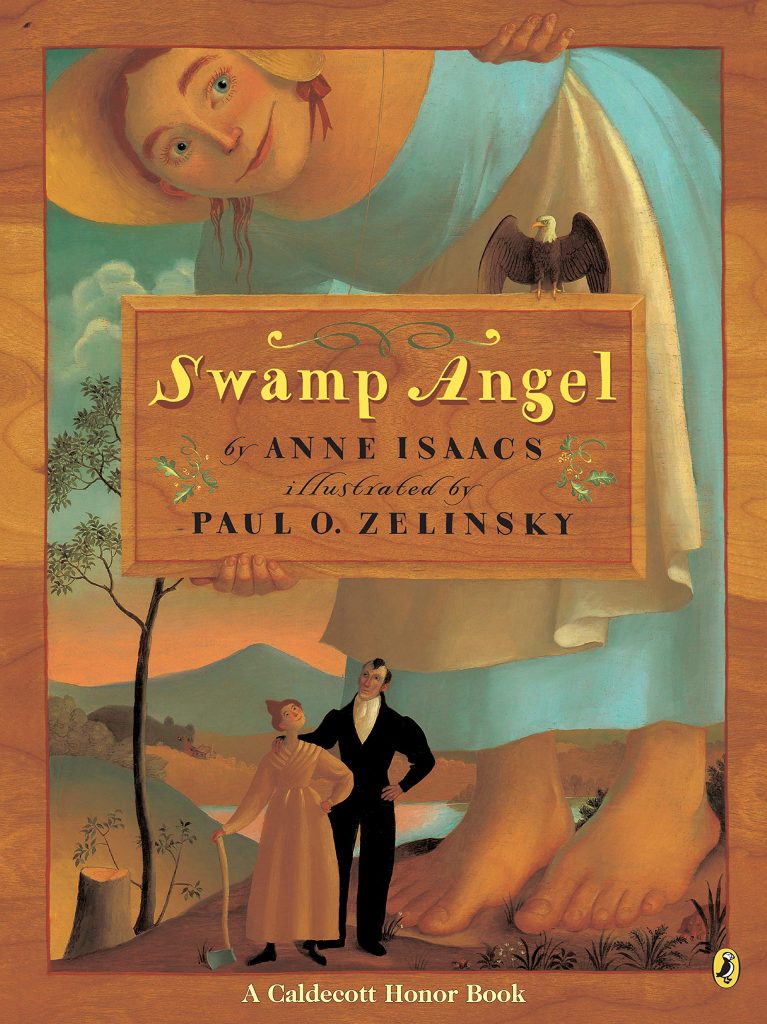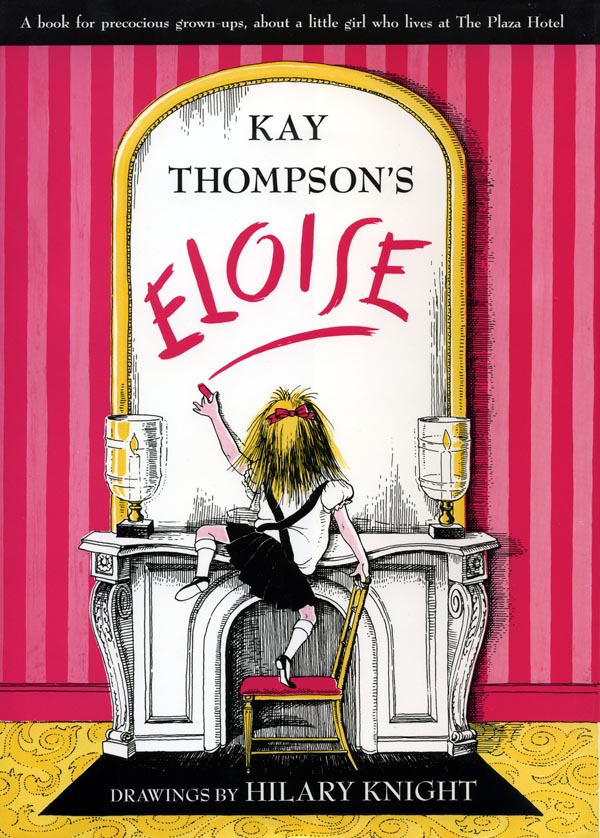
BIBLIOGRAPHY
Isaacs, Anne, and Paul O. Zelinsky (illustrator). Swamp Angel. New York: Dutton Children’s Books, 1994. ISBN 9780140559088
PLOT SUMMARY
The plucky heroine of Swamp Angel, Angelica Longrider, is born extraordinary. As a newborn, she’s taller than her mother, and at age two she builds her first log cabin. But giant Angelica doesn’t stop there. The girl—dubbed “Swamp Angel” at the tender age of twelve after rescuing some muck-mired Tennesseans—becomes the beloved champion of the Tennessee frontier. So when a big bad bear called Thundering Tarnation starts stealing winter rations out of poor settler’s food cellars, Swamp Angel signs up to hunt the beast down. Although every other hunter fails to catch the varmint, Angel isn’t deterred. When she finally spots him, Angel and the bear grapple in a fight for the ages, grabbing tornados like lassos, throwing each other into the sky, and creating such a stir that the Great Smoky Mountains are formed. Finally, Tarnation falls down dead at Angel’s feet and Tennesseans celebrate, receiving bear meat enough to fill their food cellars to bursting point. Careful stargazers can still see the legacy of Angel and Tarnation’s fight: the vague outline of a bear thrown into the heavens twinkling up in the night sky.
CRITICAL ANALYSIS
Swamp Angel is a truly exceptional tale. A great deal of the story’s charm comes from Isaacs’s mastery of the spoken language of the frontier. Tarnation the bear is deemed a “varmint” and Swamp Angel is “much obliged” for the pelt of this “most wondrous heap of trouble.” Isaacs writes flawlessly with the casual exaggeration characteristic of the tall tale narrative. “There was nothing about the child,” she nonchalantly begins, “to suggest that she would become the greatest woodswoman in Tennessee” although the newborn is bigger than her mother and is given a shiny new ax for a cradle toy. In fact, the writing fits the tall tale mold so well, readers will find themselves wondering whether this story was actually penned by Isaacs or whether she first heard the tale from an old Tennessean relative.
Furthermore, the details of the illustrations make the story come to life. Readers will notice that some of the hunters standing in line with Angel (e.g. the angry man with the bee-infested bucket of molasses and the smug man holding his giant bear trap) are the same hunters that Tarnation defeats just a page later. Readers will take note of the details of the settlers’ dress—Angel in her apron and bonnet, trappers in coonskin caps, and gentlemen in top hats. They might even spot Swamp Angel’s small but mighty red hound dog who follows her around on almost every page. Even more importantly, Zelinsky’s illustrations turn the tall tale even taller—the huge bodies of Angel and Tarnation fight across vast mountain ranges, drink up entire lakes of water, and pull down every last tree in the forest with their snores. Zelinsky’s illustrations of epic proportions pair perfectly with Isaacs’s larger-than-life heroine, making this book the perfect addition to any picture book collection.
AWARDS AND REVIEW EXCERPTS
Caldecott Medal Nominee (1995)
Pennsylvania Young Readers’ Choice Award for Grades 3–6 (1997)
An ALA Notable Book (1995)
A New York Times Best Illustrated Children’s Book of the Year (1994)
Winner of the Boston Globe/Horn Book Award (1995)
Texas Bluebonnet Award Nominee (1996–1997)
From The Horn Book:“Move over Paul Bunyan, you are about to meet Swamp Angel. . . . Visually exciting, wonderful to read aloud, this is a picture book to remember.”
From Publishers Weekly: “Zelinsky’s stunning American-primitive oil paintings, set against an unusual background of cherry, maple and birch veneers, frankly steal the show here. Their success, however, does not diminish the accomplishment of Isaacs, whose feisty tall tale marks an impressive picture-book debut.”
CONNECTIONS
- Read Swamp Angel to introduce a unit on American pioneers and life on the frontier with excerpts from other children’s books:
- Tunis, Edward. Frontier Living: An Illustrated Guide to Pioneer Life in America. ISBN 9781585741373
- Greenwood, Barbara, and Heather Collins. A Pioneer Sampler: The Daily Life of a Pioneer Family in 1840. ISBN 9780395883938
- Learn about the clothing worn by the settlers in Swamp Angel and bring settler clothing for children to try on.
- Read Swamp Angel in tandem with other tall tales:
- Keats, Ezra Jack. John Henry: An American Legend. ISBN 9780812459463
- Kellogg, Steven. Pecos Bill: A Tall Tale. ISBN 9780688140205
- Houran, Lori H., and Luke Flowers (illustrator). The Tale of Paul Bunyan. ISBN 978-1984851796
- Read Swamp Angel with other Caldecott nominees of 1995. Have a class vote to decide which one “wins” the class nomination.
- Bunting, Eve, and David Díaz (illustrator). Smoky Night. ISBN 9780152018849
- Rohmann, Eric. Time Flies. ISBN 9780517885550
- Lester, Julius, and Jerry Pinkney (illustrator). John Henry. ISBN 9780140566222
*Note—This book review was created as an assignment for a course at Texas Woman’s University.




